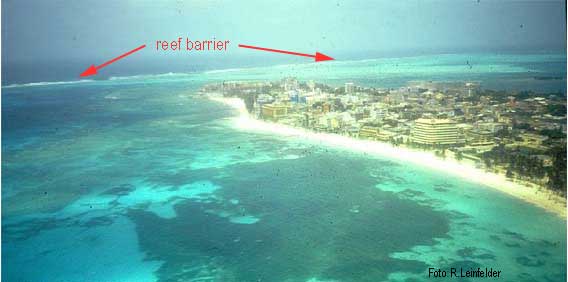
1.3.1.6 Importance of reefs for the human society
Often unknown, modern and ancient reefs are both an economic treasure and important social ressource to the entire global society. Let's see some aspects:
a) Coastal protection, creation of new land areas
Coral reefs are a natural protective system against high, threatening waves, and as such protect many thousands of kilometers of tropical island and mainland coasts. This is particularly important in hurricane and taifun areas such as the Caribbean and major parts of southeast Asia. Without the protective reef barriers, many coasts would just be eroded and beach sands would be washed away.

Figure shows the capital city San Andres on San Andres Island, Colombia which is well protected by high wave energies through a shallow high-energy reef belt. Foto Leinfelder
Sick reefs cannot maintain such protection. Although hard rock remains after a reef is dead, it is just a matter of (mostly short) time that the reef is eroded by waves and the large crowd of bioeroding organisms. Without continuing production to compensate this, reef barriers will be gone or drowned by rising sea level (present average annual sea-level rise is 2 mm). The problem is particularly augmented if living reefs are quarried for building material (see Section 1.4).
Known examples are the Maldives (see figure below) and the Tuvalu islands. Maldives reefs were overused for concrete and cement industry with the consequence that beaches were frequently washed away and floodings occur already after even smaller storms and high tides. Ironically, rock material and concrete produced by the quarried reef material was then used again to build artificial walls in the water, with the effect that currents behind the walls were even stronger and even more tourist beaches were washed away. Why? Well, a natural reef barrier does not contain a smooth outer surface but rather a very complicated rough structure composed of protrusions and hollows, all of which result in local turbulence, using up water energy. Contrasting, a simple smooth rock wall may cause backflow acceleration of currents behind the wall through the Bernoulli-effect (Maldive-example known through various personal sources).
Fig: Male, the capital of the Maldives is frequently flooded already after small storms. From Wells & Hanna (1992), used with permission.
Tuvalu which is a small archipelago state in the Pacific (next to the Fitschi islands) has become known recently by the fact that the dot.tv Internet domain is registered to this country. Since Tuvalu reefs are stressed and do not cope up with sea-level rise the entire atoll island state might be wiped out in the next 50 years. Tragically, other countries such as Australia and Newsealand appear not to be willing to let the 11.000 inhabitants of Tuvalu in. Tuvalu people have already started to run away from their beautiful paradise.
>> see additional page with figures and information on Tuvalu
Reefs do not only protect coasts but frequently also create new land which can be settled by humans. Reefs produce reef rock which is partially reworked to sands and cobbles by wave action and bioeroding organisms. These sands may be piled up during storms, creating small sand cays. They also may accumulate in the lagoons or on beaches, and prograding beaches may even fill up parts of the lagoons. Even small islands may rapidly grow provided mangroves stabilize the island coast and help trapping and accumulating more sand and muddy material.
This page is part of www.palaeo.de/edu/reefcourse,
last changes